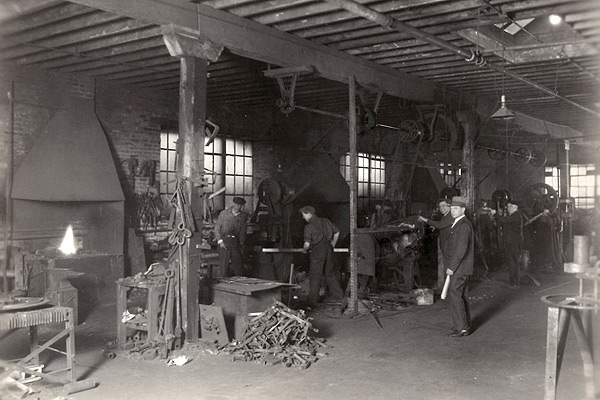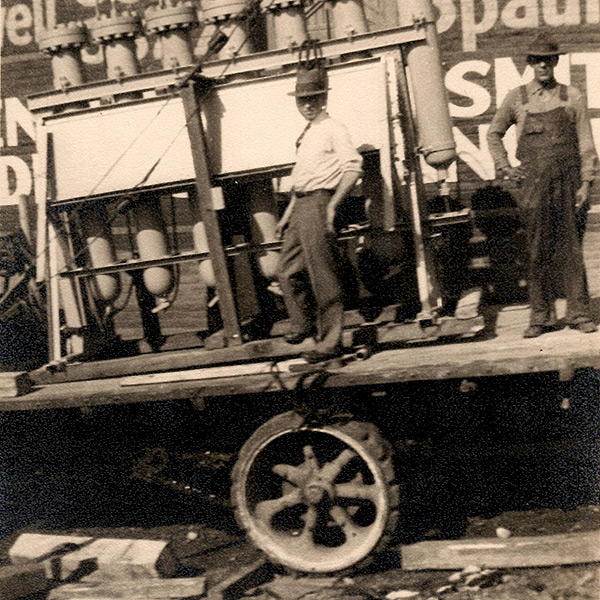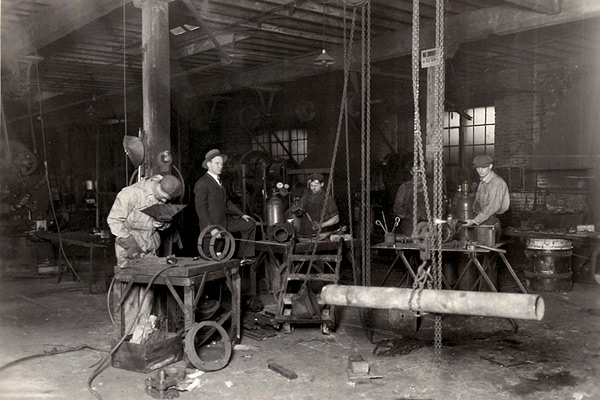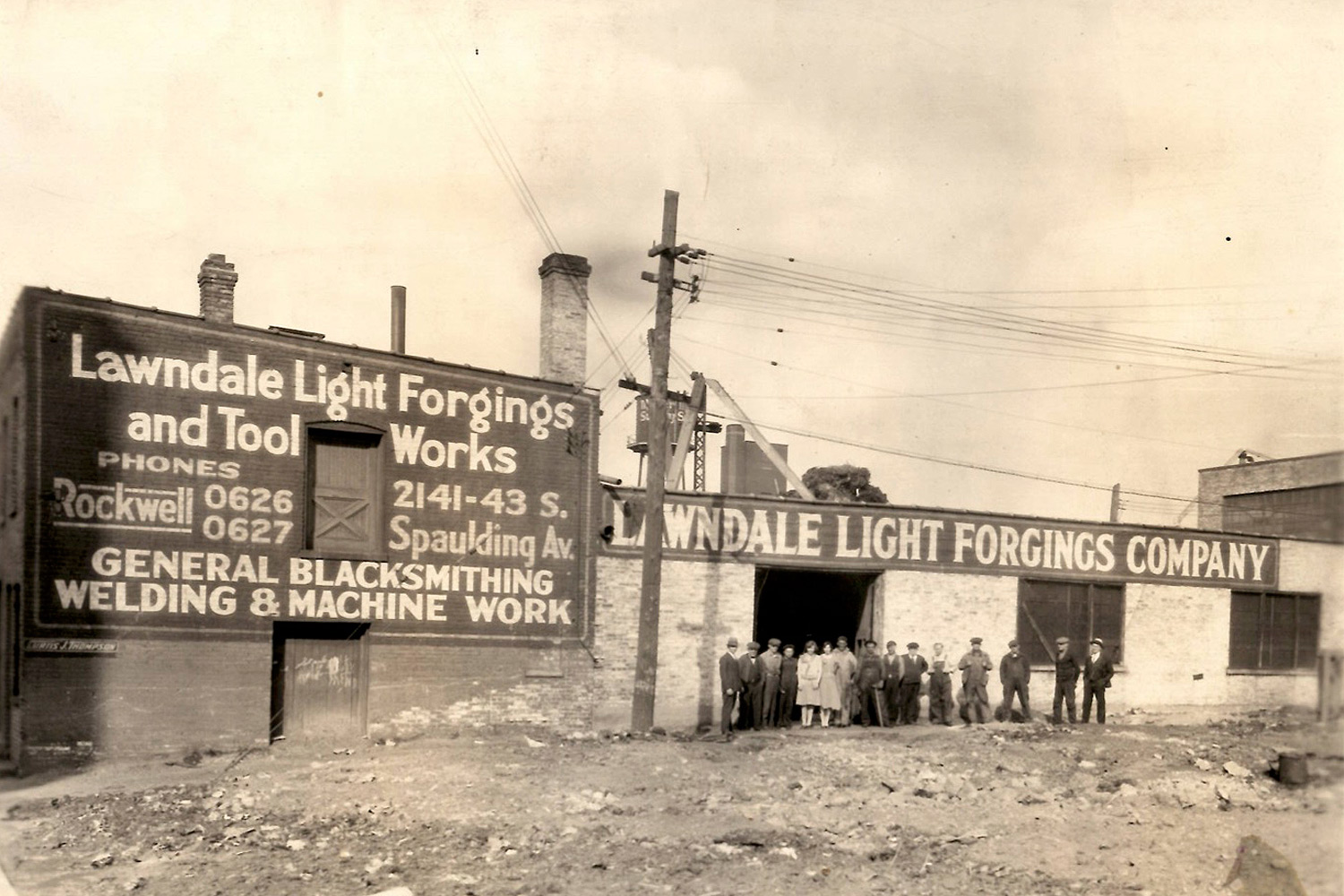Hidden among North Lawndale’s vast tracts of vacant warehouses and auto-body shops is a time machine to a neighborhood that author Harold Mayer once called “a crowded city within a city.” Before blockbusting and white flight and the Eisenhower Expressway, Paul Russell’s great grandfather was rending white-hot chunks of steel into chain links tough enough to pull battleships.
A century later, Paul, 31, plucks a rod from the 2,000-degree furnace and cranks it around a vise until it sets into a neat oval shape. He’s still here, in a musty workshop in the 2100 block of South Spaulding Avenue, fine-tuning the work of the city’s last
neighborhood blacksmith.
Between tectonic shifts in technology, manufacturing and the surrounding urban landscape, each generation brought some new headwind that swept all the city’s other mom-and-pop forges away from Chicago or out of business. Through 89 years, Lawndale Forge has defied them all.

Owner Greg Russell, Paul’s father, credits his the shop’s longevity to his family’s balance of expertise and stubbornness.
“We’re just very good blacksmiths who never had enough sense to go make money any other way,” Greg laughed. “I do love manufacturing things—I guess I just picked the wrong generation to be a manufacturer.”
Russell’s shop isn’t the only steel forge in the city, or even its last family-owned metallurgist—Larson Forgings has been pumping out machine parts from its Hermosa campus since the 1890s.
But with seven employees, no other business is molding hand-crafted tools so closely to the model of the industrial-era neighborhood blacksmith.
The shop produces hundreds of unique tools for clients local and global—“from baby food to battleships,” Greg says. They meld grappling hooks for naval fleets, steel beams for skyscrapers and a patented trailer hitch they’re confident can haul more cargo than anything made overseas.
A century of advances has equipped the forge with a few mechanical-powered processes, like a 200-ton “bulldozer” press capable of bending six-inch thick beams like spaghetti, but it’s kept mostly the same layout since Ralph William Russell set up shop in 1929.
Born in Shropshire, England to a family of smithies stretching back generations beyond counting, Ralph set out for Chicago in 1907 with eyes on a wider clientele for his skills. He found an apprentice job in the Union Stockyards shoeing horses, eventually earning enough money to move into a bungalow in the 2400 block of South Hamlin Avenue.

The rise of automobiles in the 1920s pushed Ralph toward private enterprise. Other ferriers insisted the contraptions were a fad, but the Englishman bet he could build a business that reached beyond horseshoes.
Ralph found a brick storefront with an upstairs hayloft on Spaulding Avenue, a few steps from the Cermak Road streetcar line.
The city’s unquenchable appetite for steel got the forge busy immediately, Greg said. Ralph and his intimate team of workers—including his son, Greg’s father—fitted pipes for the city’s water department and molded telephone parts for Western Electric.
But starting around the 1950s, when Greg’s father was in charge, the invention that helped launch their business began to decimate North Lawndale, he said.
“The automobile changed the complexion of the neighborhood more than anything,” Greg said. “In the 20s up through World War II you had people living and working in close proximity, so you would have a professional class living a couple blocks away from working class housing. It made for a much healthier community.”
Some of Lawndale’s residents welcomed a new wave of African American neighbors in from the South, but many of its Czech and Italian communities were swept away by racist hysteria proliferated by “panic-peddler” real estate brokers. The neighborhood’s Jews soon followed, making for suburban enclaves on the North Shore.
Even more longtime neighbors bolted for the suburbs after riots sparked by the 1968 assassination of Martin Luther King, Jr. scorched the West Side, speeding the neighborhood’s economic slump into a spiral.
“After ‘68, just about everyone ran out of here,” said Blanche Killingsworth, chair of the North Lawndale Historical and Cultural Society.
Everyone, Killingsworth added, but Lawndale Forge.
“These guys stayed, and it sent a powerful message,” said Killingsworth, who’s lived in Lawndale since she moved from Mississippi in 1961. “It showed the city, ‘This is home, and my business can still be successful here.’”
That message was not heeded by the city’s manufacturing giants. Sears abandoned its Homan Square headquarters in 1973, arresting the beating heart of North Lawndale’s economy.
The same forces were closing in on the domestic steel forging industry, especially in 1984, when AT&T bought Western Electric and outsourced nearly all its manufacturing to East Asia. But the whole time, the Russells never considered leaving, Greg said.
“There was always this altruistic notion that we should treat the existence of this place as a kind of stewardship,” Greg said. I grew up in a Presbyterian church environment… and you’re just always thinking in those terms.”
He owes the survival of the family business to the quality of their product—especially their trailer hitches—and their unique ability to fulfill specialty and one-off orders, he said. They’ve also made a steady transition to online sales, now selling nearly a sixth of their products over the Internet.
But with newer technologies like 3D printing driving blacksmiths even closer to obsolescence, Lawndale Forge is planning a sharp pivot in an effort to stay viable, Greg said. It starts with Paul.

Unlike his ancestors, Paul grew up using metalworking as a creative outlet, not just a practical one. He’s sold multiple steel sculptures to galleries and public works agencies—including the Chicago Park District, which mounted “Ancient Protocols,” his shimmering display of two dog-sized dragonflies, in North Lawndale’s Douglas Park.
“Once you get steel to the right temperature, you can move it around just like clay,” Paul said. “So after I learned it well enough, I just started applying a lot of those same kinds of [artistic] techniques to forging metal.”
Metalworking is seeing a revival among artists, many of whom lack the technical skills to get past the inherent danger of presses and furnaces, Paul said.
Last year, the family bought a vacant barber shop on an adjoining property and began gutting it to build a workshop space. The School of the Art Institute of Chicago is lining up with grant money to launch metal sculpture classes once it’s ready, according to administrators.
The new classroom could be the key to opening a curriculum long sought by the school, according to Paul Coffey, its dean of community engagement.
“Once we were introduced to these guys we realized they were absolute wizards with metal — and more than that, they’re beautiful artisans,” Coffey said. “Their craftsmanship is something we really want all of our students to have.”




Comments are closed.